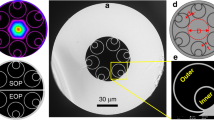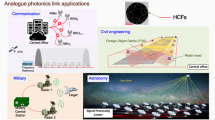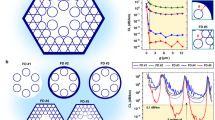Abstract
Following the discovery by Kao and Hockman1,2,3 that ultra-low-loss optical fibres could be made from pure silica through the elimination of impurities, the ability to guide signals effectively at optical wavelengths has been assured. But there remains an important region of the spectrum—from 30 to 3,000 GHz (the millimetre–submillimetre band)—where low-loss waveguides are unknown. The main problem here in finding low-loss solids is no longer one of eliminating impurities, but is due to the presence of intrinsic vibration absorption bands4,5,6. And the use of highly conducting materials is also precluded owing to high skin-depth losses7,8 in this part of the spectrum. Here we show that a combination of material and waveguide geometry can circumvent these difficulties. We adopt a ribbon-like structure with an aspect ratio of 10:1, fabricated from ceramic alumina (Coors' 998 Alumina), and the resulting waveguide has an attenuation factor of less than 10 dB km-1 in the millimetre–submillimetre band. This attenuation is more than 100 times smaller than that of a typical ceramic (or other dielectric) circular rod waveguide and is sufficient for immediate application.
This is a preview of subscription content, access via your institution
Access options
Subscribe to this journal
Receive 51 print issues and online access
$199.00 per year
only $3.90 per issue
Buy this article
- Purchase on Springer Link
- Instant access to full article PDF
Prices may be subject to local taxes which are calculated during checkout




Similar content being viewed by others
References
Kao,K. C. & Hockman,G. A. Dielectric fiber surface waveguides for optical frequencies. Proc. IEE 133, 1151–1158 (1966).
Agrawal,G. P. Fiber Optic Communication Systems (Wiley Series in Microwave and Optical Engineering, New York, 1997).
Marcuse,D. Light Transmission Optics (Van Nostrand-Reinhold, New York, 1972).
Afsar,M. N. & Button,K. J. Millimeter-wave dielectric measurement of materials. Proc. IEEE 73, 131– 153 (1985).
Birch,R., Dromey,J. D. & Lisurf, J. The optical constants of some common low-loss polymers between 4 and 40 cm-1. Infrared Phys. 21, 225–228 (1981).
Afsar,M. N. Precision dielectric measurements of nonpolar polymers in millimeter wavelength range. IEEE Trans. Microwave Theor. Tech. 33, 1410–1415 (1985).
Yeh,C. in American Institute of Physics Handbook (ed. Gray, D. E.) 3rd edn (McGraw Hill, New York, 1972).
Ramo,S., Whinnery,J. R. & Van Duzer, T. Fields and Waves in Communication Electronics 2nd edn (Wiley, New York, 1984).
Yeh,C. Elliptical dielectric waveguides. J. Appl. Phys. 33, 3235–3243 (1962).
Yeh,C. Attenuation in a dielectric elliptical cylinder. IEEE Trans. Antenna Propag. 11, 177–184 ( 1963).
Yeh,C., Shimabukuro,F. I. & Chu, J. Ultra-low-loss dielectric ribbon waveguide for millimeter/submillimeter waves. Appl. Phys. Lett. 54, 1183– 1185 (1989).
Yeh,C., Ha,K., Dong,S. B. & Brown,W. P. Single-mode optical waveguides. Appl. Opt. 18, 1490– 1504 (1979).
Taflove,A. Computational Electrodynamics, the Finite-Difference Time-Domain Method (Artech House, Norwood, MA, 1995).
Yeh,C., Casperson,L. & Szejn, B. Propagation of truncated gaussian beams in multimode fiber guides. J. Opt. Soc. Am. 68, 989– 993 (1978).
Koul,S. K. Millimeter Wave and Optical Dielectric Integrated Guides and Circuits (Wiley Series in Microwave and Optical Engineering, New York, 1997).
Shimabukuro,F. I. & Yeh,C. Attenuation measurement of very low loss dielectric waveguides by the cavity resonator method applicable in the millimeter/submillimeter wavelength range. IEEE Trans. Microwave Theor. Tech. 36, 1160–1166 (1988).
Yeh,C. A relation between α and Q. Proc. Inst. Radio Eng. 50, 2145 (1962).
Acknowledgements
We thank C. Stelzried, A. Bhanji, D. Rascoe and M. Gatti of JPL for their encouragement and support. Expert assistance from M. Ostrander in machining, R. Cirillo in experimental measurements and C. Copeland in graphic works is appreciated. The research was carried out at the Jet Propulsion Laboratory, California Institute of Technology, under a contract with NASA.
Author information
Authors and Affiliations
Corresponding author
Rights and permissions
About this article
Cite this article
Yeh, C., Shimabukuro, F., Stanton, P. et al. Communication at millimetre–submillimetre wavelengths using a ceramic ribbon. Nature 404, 584–588 (2000). https://doi.org/10.1038/35007036
Received:
Accepted:
Issue Date:
DOI: https://doi.org/10.1038/35007036
Comments
By submitting a comment you agree to abide by our Terms and Community Guidelines. If you find something abusive or that does not comply with our terms or guidelines please flag it as inappropriate.



